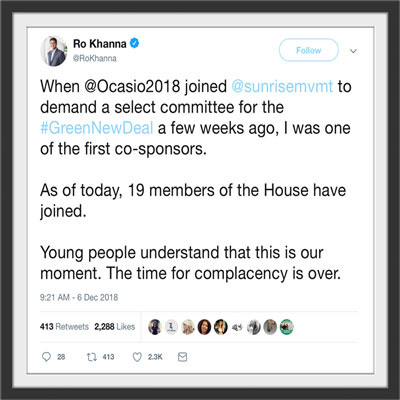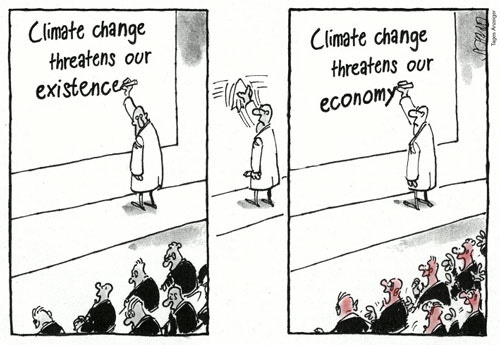
What’s pie got to do with it? | Element5 Digital | unsplash.com
ONE | THE AUDACITY OF HOPE: And pumpkin pie climate action
A previous issue noted suggestions on who to follow among the Climeratti (my lame new coinage for notable climate change advocates on Twitter). Among them is Katherine Hayhoe (@Khayhoe), an atmospheric scientist and director of the Climate Science Center at Texas Tech University. On 01.06.19, The Guardian published a good Q-A with Hayhoe, who won this Twitter follower’s undying affection when she took a break from baking pumpkin pies Thanksgiving weekend to respond to the Trump administration’s attempt to deep six the National Climate Assessment, which she had a hand in producing. (A hand I keep thinking of as being covered in flour). If you fail to click the link above, here’s a pass-it-forward quote from her: “Fear is a short-term spur to action, but to make changes over the long term, we must have hope.” And:
The most important thing is to accelerate the realisation that we have to act. This means connecting the dots to show that the impacts are not distant any more: they are here and they affect our lives. It also means talking about solutions. The technology and knowledge are there. The economics already make sense. In Texas, where I live, the biggest military base, Fort Hood, switched last year to renewables because they were cheaper than natural gas. And finally, it means weaning ourselves off fossil fuels, which is challenged by the fact that the majority of the world’s richest companies have made their money from the fossil fuel economy – so the majority of the wealth and power remains in their hands.
___
TWO | WHEN THE DEEP SIX TEAM BLOWS IT: Not so marginal
There is a cabal of people who believe a cabal of people secretly run the US — a.k.a., the Deep State. But those concerned about climate action would do well to pay close heed to the Trump White House’s Deep Six team. Of course, the attempt to bury the National Climate Assessment on Black Friday backfired, as the report lit up front pages because of alert editors, interrupted bakers (see above) and a slow news day. Take a deep dive at the link. But out of the box, it makes a significant point. Right now, and henceforth, climate change will hit hardest at lower-income and marginalized communities. (Not to mention you, too, eventually, if you and your family, like me and mine, are a littler higher-income and non-marginalized):
More frequent and intense extreme weather and climate-related events, as well as changes in average climate conditions, are expected to continue to damage infrastructure, ecosystems, and social systems that provide essential benefits to communities … Impacts within and across regions will not be distributed equally. People who are already vulnerable, including lower-income and other marginalized communities, have lower capacity to prepare for and cope with extreme weather and climate-related events and are expected to experience greater impacts.
___
THREE | SHIFTING TIMES: The past is not the future anymore
The massive National Climate Assessment, representing decades of work from more than 300 authors, is pretty blunt. And long — so this 11.23.18 summary by The Atlantic is a good overview that makes a significant point: “The assumption that current and future climate conditions will resemble the recent past is no longer valid.”
For centuries, humans have lived near the ocean, assuming that the sea will not often move from its fixed location. They have planted wheat at its time, and corn at its time, assuming that the harvest will not often falter. They have delighted in December snow, and looked forward to springtime blossoms, assuming that the seasons will not shift from their course. Now, the sea is lifting above its shore, the harvest is faltering, and the seasons arrive and depart in disorder.
___
FOUR: STORIES WE TELL: What Bull …
Since we first gathered around bonfires against the darkness and the watchful eyes of prey animals, we’ve told stories to explain the unexplainable, the worrisome and unknown. Anthropologist Susie Crate has spent years gathering climate change stories that indigenous cultures are now telling themselves. Crate and her daughter are featured in the 2015 documentary, “The Anthropologist,” as it follows them to Kiribati, Siberia, the Chesapeake Bay and the Peruvian Andes, to see how indigenous people cope with climate change. In my past life as a newspaperman, I interviewed Crate for a 10.07.17 story in advance of a local screening of the film. She talked to me about how Siberian elders have changed their tune about the Siberian winter:
Elders in the region speak of changes in what has been known for ages as “the Bull of Winter,” Crate said. “This is a way they explain this period of winter, when, for about three months, it gets too cold and dry to snow. It’s just this frozen stillness. They talk about, ‘The Bull of Winter’ has arrived.’” Then, in early March, the frigid temperatures begin to lift a bit, “and one of the horns starts falling off,” she said. “A few weeks later, they lift even more, and another horn falls off. A few weeks later, as spring comes, it starts to snow again. The bull’s head falls off, and spring is in full effect.”… Many of the elders she speaks with these days talk about the Bull of Winter “not arriving anymore,” Crate said, as temperatures warm. “It’s starting to be they can no longer talk about the Bull of Winter as something that occurs every year.”
___
FIVE | TWEET OF THE DAY: Sunrise on our shoulders
Unless they figure out how to upload the brains of us grey hairs into the cloud (most likely delivered via Prime to an Amazon-owned cloud), us, um, elders, will likely not be around if the worst climate change scenarios develop. But avoiding worst-case scenarios, by cumulative action among those with grey hair and those with, well, more hair, if not purple hair, is essential. To that end, if you do not already know of the Sunrise Movement (@sunrisemvmt), get to know. Here is how they describe themselves: “We are building an army of young people to stop climate change and create millions of good jobs in the process. This dark time in America must come to an end.” And in my continuing lobby for climate change tattoo phrases, I nominate another: “The time for complacency is over.”

___
SIX | PREYING ON THE MIND: ‘Thoughts of Dog’ to the Rescue
Climate change round-ups can get heavy, what with rising seas and melting Siberias. But remember: the wolves beyond the periphery of our Cro-Magnon campfires became today’s lovable, goofy dogs. If you need a pick-me-up AT ANY TIME OF DAY while contemplating climate change, follow ‘Thoughts or Dog’ on Twitter. If you’re not on Twitter, I heartily recommend you get an account just to follow “Thoughts of Dog.” With 2.1 million followers, it is one of Twitter’s most popular accounts, right up there with Obama’s. It’s by far one of the sweetest, dearest, most lovable thing on social media. Without being sickly sweet, the “human” who channels “Thoughts of Dog“ exquisitely captures the pure heart of lovable doggedness. We must save the planet, after all, not only for ourselves. But for our dogs — and cats, and gerbils and tarantulas, and guinea pigs and ….
PS: Thoughts of Dog pinned tweet: sometimes. the human presses their noggin against mine. to figure out what i’m thinking. so i just think really hard. about how much i love them. and hope they figure it out

___
SEVEN: WRITE STUFF: Cli-fi’s role in climate change awareness
Last issue’s mention of The Cli-Fi Report, a compendium of resources on the growing genre of “climate fiction,” surfaced the guy, Dan Bloom, who coined ‘cli-fi’ itself. From his home base in Taiwan, Dan has been evangelizing the significance of cli-fi to rouse people via powerful storytelling. The Five Books website profiled Dan’s personal favorites in cli-fi, which include Barbara Kingsolver’s “Flight Behavior,” which the last issue of Changing Climate Times keyed off of for a disquisition on the (monarch) butterfly effect. Here is Dan’s response to the cli-fi question that comes instantly to mind: What on God’s no-longer-so-green Earth can climate change literature achieve that scientific and political discussion cannot?
The key question! Every day, all over the world, online and in print, in newspapers and magazines, there are scientists and academics droning on and on in boring ways about this and that in terms of climate change. They never talk about emotions, they never talk about culture, they never talk about poetry. It’s all PhD talk and political punditry, and it comes from both the right and the left … But come the novels that are part of what we now call climate change literature, they can and are making a difference. They use heart to write stories about these issues, not brain. They create characters the reader will care about and perhaps even identify with. Novels are about empathy. Scientific and political discussions in the media are never about empathy. The American writer Sarah Stone said it best in a review of Edan Lepucki’s novel California. She wrote that if we survive, “it will be in part because of books like this one, which go beyond abstract predictions and statistics to show the moment-by-moment reality of a painful possible future, the price we may have to pay for our passionate devotion to all the wrong things.”
__
EIGHT | THE FIRST STEP: Admitting you have a cli-fi problem
True confessions/shameless self-promotion. Well, not really, since my own cli-fi work-in-progress, “Saint Stephen’s Dream: A Space Opera,” is currently stalled out like some guy’s half-built catamaran under a garage tarp. But here’s the trailer for the space opera (the singer is Kathleen Coffee), a piece I staged in part for a festival years ago. The project has been nagging at me to finish it. Maybe a podcast? Being a space opera, it has songs, as Earth goes into toxic shock from the effects of the human race upon the Gaia organism and so it attempts to recalibrate and shrug off the fever it’s experiencing. The humans who are able to then evacuate into low-earth orbit, where — being humans — they continue their age-old conflicts. That’s the back-story behind “Damn the Torpedoes” from the space opera (free video excerpt here and full song here — but it’ll cost you 99 cents! Or hear it free at this Soundcloud playlist). I need a cli-fi coach to yell at me: “Get back out there on the cli-fi playing field, son! You can DO this!”
__
NINE: PASS IT FORWARD
This is really not a mercenary newsletter, though I am an underemployed writer/storyteller. Changing Climate Times will eventually go to a monthly subscription, a la the substack.com newsletter model, so we can better afford life and feed the cats. For now, it’s in the ‘Hey, pass on word and grow the audience’ stage. Feedback and suggested articles and links welcome! Subscribe and help out if you’re climate change-conscious. Forward the newsletter or link to its companion website: changingclimatetimes.substack.com. Much appreciated! | Douglas John Imbrogno and climate change catvocates Gizmo and Luna.
___
TEN | P.S.: You Promised Cartoons



